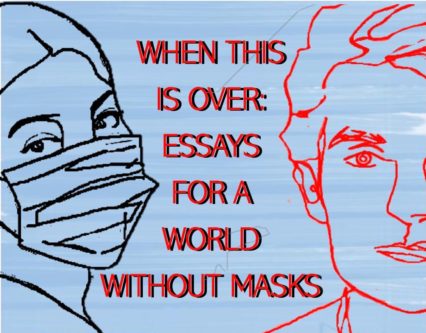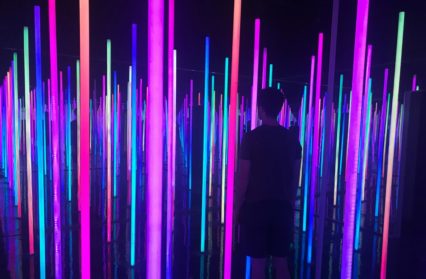Wales Arts Review asked some of Wales’s top writers to pen some thoughts on the future. This new series brings together a wide variety of perspectives and ideas in a vibrant array of styles and forms, expressing hopes for a new way of doing things when the Covid-19 coronavirus is finally overcome. Political, personal, sociological, ecological, cultural – this is an evolving tableau of ideas. Here Zoë Brigley examines the space beyond humans where nature always did and always will exist.
In January 2020 before the COVID-19 pandemic had taken hold in the U.S., my children and I took a trip to an abandoned shopping mall. Run-down malls have a symbolic significance in America: a legacy of the 2000s and the terrible recession that many places have never really shaken. In Gone Girl, Gillian Flynn, describes a bankrupt mall in mythical terms as “two million square feet of echo.” In the novel, the empty mall is left to criminals and the poor, but here I was driving under the cracked mall signage, entering a nondescript and beat up storefront with my two small kids.
 We came to see a phenomenon called Otherworld, a “32,000 square foot immersive art installation” in Columbus. The blurb on the website promises “Mysteries unfold as you explore over 40 rooms filled with large-scale interactive art, mixed reality playgrounds and secret passageways. It’s an all new kind of art experience where visitors are encouraged to freely explore and interact with a surreal world of science fiction and fantasy.”
We came to see a phenomenon called Otherworld, a “32,000 square foot immersive art installation” in Columbus. The blurb on the website promises “Mysteries unfold as you explore over 40 rooms filled with large-scale interactive art, mixed reality playgrounds and secret passageways. It’s an all new kind of art experience where visitors are encouraged to freely explore and interact with a surreal world of science fiction and fantasy.”
The day I visit with my kids, I have a hard time getting the eldest inside. The entrance is a David Lynch style corridor hung with red velvet curtains. But once in, the children soon get into the spirit of things. They climb into a huge red mouth, burrow into the belly of a hairy monster, and find inside it a beating heart. There is a room with mirrors where we are refracted and reflected a hundred times, a room where opening a coffin turns the light from sepia to technicolor, a room like mad scientist’s laboratory. We fly through the corridors, the twists and turns, test the limits of the 32,000 feet.
But while the children play, something bothers me. In one room, a plastic tree unfurls at the center. In another, stars glimmer on the ceiling, while in another fish are projected on the walls. These are the rooms I like the least. What are we seeking in these human-made replicas?
The children seen dissatisfied now. “Is that all there is?” asks the youngest, as we take a turn through the rooms for the third time. Whatever pleasures there are in lights, colour, and mirrors, there is something superficial about it all, and I can’t help thinking of the site’s former use: probably a department store in its prime, jewel of American consumerism and high capitalism. But what is it that we are being sold here with all this spectacle?
When my husband picks us up in the litter-strewn lot of the empty mall, he asks me how it went, and tell him that it was amazing, magical, fun. What I don’t mention is a nagging feeling. What I don’t say is that something about Otherworld is ultimately unsatisfying.
Fast forward to March 2020, and we are in lockdown in Ohio. I read the news anxiously about potential social distancing in the UK. I lie awake at night thinking about older relatives at risk back in Wales. I am relieved when the lockdown comes to the US too. In the US and UK we are forced to stay in our homes, only leaving for trips to the supermarket or daily exercise in the local area.
But when the lockdown comes, when social worlds are closed to us, something strange happens. The newspapers print photographs of queues of cars in Snowdonia, and Porthcawl Beach is bustling despite the lockdown. The first weekend of the lockdown here in Ohio, we drive to a local lake that is normally a quiet spot, but we turn back from the main carpark because the lot is overflowing with cars. Further down the lakeshore, we find a quiet place to park. At the lakeside, a group of people gather, despite the warnings, to be baptized. A white man in a baseball cap lowers them one by one into the murky water, shouting: “In the name of the father and the son and the holy ghost.” Through his binoculars, our eldest kid watches crowds of people walking across the dam to see the views.
What is this logic? How strange that the first instinct of many is to visit spectacular sites of nature or holiday spots despite the warnings about social distancing. I remember the visitors to Otherworld, charging around the dark interior, demanding to be entertained, circling around the same rooms over and over again. Are we making nature our immersive experience now that places like Otherworld are off-limits?
Now the circle closes. To flatten the curve, we stay in our local area, on our daily exercise forced to examine unspectacular paths and everyday hedges. But is there something we could find there, something more nourishing and less superficial?
The ancient Celts believed in an Otherworld. In Welsh and Irish myth, the Otherworld existed beside our own, on the edge of where we were living, and on occasion intruding or inviting visitors in. The hero would find a ball of silver thread rolling away into a mist that would be a portal to a world that was not our own, but filled with the things that we like to forget or ignore.
In the shutdown, I am caught in the circle of my own neighborhood, but it is not for the first time. This time last year, I was grieving a late and terrible miscarriage. I saw no one, went no further than my house if I could help it, but I found myself walking the railroad tracks a few streets away from my house. I would wander through the woods, and at first, I found nothing remarkable. That spring, branches moved faintly in the wind, and the white and purple hepatica flowers pushed daintily through leaf litter under the trees.
But maybe the ball of twine left for us follow is the edge of a real Otherworld, because we have seldom as a culture appreciated the eeriness and beauty of nature in its most mundane and unspectacular forms. When I was grieving and walking in the scrubby woods last year, I felt a sudden relief when a thought struck me that even here, everything was alive. The woods were alive, the branches were alive, the ants scaling the branches were alive. Everything seemed animated and lit with an eerie beauty then.
There is nothing that is good about COVID-19, nothing that can make up for the deaths, the illness, the institutional blunders and mis-steps, the losses, but if we must endure it, perhaps there is something we can admit. As we try to survive physically and mentally in lockdown, we are being forced to pay attention. We are being asked to look at how we are living. We are stepping out of the spectacle of capitalism, and although we treat the earth and nature with routine contempt, the world does not revolve around human beings. It never did. There is an Otherworld beyond humans, and it is awake. It has always been awake.
Check out the other articles in Wales Arts Review’s ‘When This is Over’ series.
Zoë Brigley is a poet and nonfiction writer, published by Bloodaxe, Parthian, and Routledge, currently Assistant Professor at the Ohio State University.











